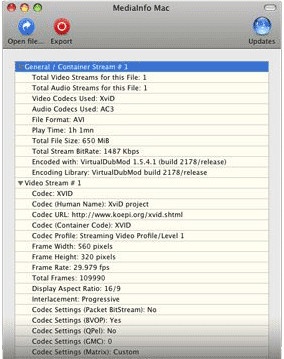Download Invisor - Media File Inspector for macOS 10.7.3 or later and enjoy it on your Mac. Invisor displays technical information about your video, audio and photo files with ability to compare collected data. I’m sure plenty of folks know this, but like literally anything else in the world, plenty of folks don’t. This is an incredibly handy feature of developing responsive sites and testing them on as real of devices as you can. Plus, it doesn’t cost anything additional beyond your macOS computer. Step 1) Download Xcode The iOS Simulator is an app that comes bundled with Xcode. Or press Command+Option+C (Mac) or Control+Shift+C (Windows, Linux, Chrome OS). When you want to see logged messages or run JavaScript, press Command+Option+J (Mac) or Control+Shift+J (Windows, Linux, Chrome OS) to jump straight into the Console panel. See Open Chrome DevTools for more details and workflows.
Media Inspector For Mac Os
If that doesn't suit you, our users have ranked 11 alternatives to Media Inspector and three of them are available for Mac so hopefully you can find a suitable replacement. Other interesting Mac alternatives to Media Inspector are MovieScanner (Free) and VideoSpec (Free).
Chrome DevTools is a set of web developer tools built directly into the GoogleChrome browser. DevTools can help you editpages on-the-fly and diagnose problems quickly, which ultimately helps you build betterwebsites, faster.
Check out the video for live demonstrations of core DevTools workflows, including debugging CSS,prototyping CSS, debugging JavaScript, and analyzing load performance.
Open DevTools
There are many ways to open DevTools, because different users want quick access to differentparts of the DevTools UI.
- When you want to work with the DOM or CSS, right-click an element on the page and select Inspectto jump into the Elements panel. Or press Command+Option+C (Mac) orControl+Shift+C (Windows, Linux, Chrome OS).
- When you want to see logged messages or run JavaScript, press Command+Option+J(Mac) or Control+Shift+J (Windows, Linux, Chrome OS) tojump straight into the Console panel.
See Open Chrome DevTools for more details and workflows.
Get started
If you're a more experienced web developer, here are the recommended starting points for learning howDevTools can improve your productivity:
Discover DevTools
The DevTools UI can be a little overwhelming... there are so many tabs! But, if you take sometime to get familiar with each tab to understand what's possible, you may discover that DevToolscan seriously boost your productivity.


Device Mode
Simulate mobile devices.
Elements panel
View and change the DOM and CSS.
Console panel
View messages and run JavaScript from the Console.
Sources panel
Debug JavaScript, persist changes made in DevTools across page reloads,save and run snippets of JavaScript, and save changes that you make in DevTools to disk.
Media Inspector Mac Free
Network panel
Media Inspector For Mac Catalina
View and debug network activity.
Performance panel
Note: In Chrome 58 the Timeline panel was renamed to the Performance panel.Find ways to improve load and runtime performance.
Memory panel
Note: In Chrome 58 the Profiles panel was renamed to the Memory panel.Profile memory usage and track down leaks.
Application panel
Inspect all resources that are loaded, including IndexedDB or Web SQL databases, local andsession storage, cookies, Application Cache, images, fonts, and stylesheets.
Security panel
Debug mixed content issues, certificate problems, and more.
Community
File bug reports and feature requests in Crbug, which is the engineering team's bug tracker.
If you want to alert us to a bug or feature request but don't have much time,you're welcome to send a tweet to @ChromeDevTools. We reply and sendannouncements from the account regularly.

For help with using DevTools, Stack Overflow is the best channel.
To file bugs or feature requests on the DevTools docs, open a GitHub issueon the Web Fundamentals repository.
DevTools also has a Slack channel, but the team doesn't monitor itconsistently.
Feedback
Media Inspector For Mac Download
Media Inspector For Mac Windows 10

Other versions (packaging, OS, interface...) are also available ()
See change log
You can also use MediaInfoOnline to test MediaInfo without installing any software on your computer.
The MediaInfo data display includes:
- Container: format, profile, commercial name of the format, duration, overall bit rate, writing application and library, title, author, director, album, track number, date, duration...
- Video: format, codec id, aspect, frame rate, bit rate, color space, chroma subsampling, bit depth, scan type, scan order...
- Audio: format, codec id, sample rate, channels, bit depth, language, bit rate...
- Text: format, codec id, language of subtitle...
- Chapters: count of chapters, list of chapters...
MediaInfo analyticals include:
- Container: MPEG-4, QuickTime, Matroska, AVI, MPEG-PS (including unprotected DVD), MPEG-TS (including unprotected Blu-ray), MXF, GXF, LXF, WMV, FLV, Real...
- Tags: Id3v1, Id3v2, Vorbis comments, APE tags...
- Video: MPEG-1/2 Video, H.263, MPEG-4 Visual (including DivX, XviD), H.264/AVC, H.265/HEVC, FFV1...
- Audio: MPEG Audio (including MP3), AC3, DTS, AAC, Dolby E, AES3, FLAC...
- Subtitles: CEA-608, CEA-708, DTVCC, SCTE-20, SCTE-128, ATSC/53, CDP, DVB Subtitle, Teletext, SRT, SSA, ASS, SAMI...
MediaInfo features include:
- Read many video and audio file formats
- View information in different formats (text, sheet, tree, HTML...)
- Customise these viewing formats
- Export information as text, CSV, HTML...
- Graphical user interface, command line interface, or library (.dll/.so/.dylib) versions available
- Integrate with the shell (drag 'n' drop, and Context menu)
- Internationalisation: display any language on any operating system
- Localisation capability (for which volunteers are needed - please contact us!)
License:
It is Open-Source software which means that end users and developers have freedom to study, to improve and to redistribute the program (BSD-style license).